![Absentee Father Statistics [Shocking Research]](https://wp.bedbible.com/wp-content/uploads/2022/09/Absentee-father-statistics.png)
We’re living in a busy world where an absent father is becoming more and more normal due to several factors such as career, divorce, death, etc. We know that this development is expected to keep increasing, but we haven’t focused on the consequences for the child.
This report shows how many absent fathers there are but also focuses on what it does to a child to live in a fatherless home.
All the statistics on absent fathers and fatherless homes will continuously be updated, so you all the time can follow the development in real time. Here’s what you’ll find in this report:
- How many absentee fathers
- Consequences and health risks of a fatherless home
- Most common explanations for an absent father
- General absentee father statistics
- How is an absentee father defined?
- Conclusion
➔ Key Takeaways
- 20.7% of all dads are defined as “absent fathers” (That’s +7.000.000 absent dads in the US)
- 1 out of 4 children (23.6%) lives without a father (That’s 15.782.000 children without a dad in the US)
- 57% of fatherless homes are owned by an African-American, Hispanic 28%, and white 15%
- Children of absent dads are 2 times more likely to commit suicide
- Mississippi is the state with the most absent fathers. Almost 40% are fatherless homes
- The median income is 35.400$ pr. year for a fatherless home. Two-parented household is 85.300$
- 6 out of 10 young people who commit suicide come from a fatherless home
- 3 out of 4 rapists commit the crime due to feelings that involve an absent father
- Children of absent fathers have their sexual debut 4 years before anyone else
1) How many absentee fathers
1.1) Fathers with no children
- 4 out of 5 fathers of children live with some of those (79.8%)
3 out of 4 dads live with all of their children (72.6%)
- 20.7% of all dads are defined as absent fathers. This means that there are +7.000.000 absent dads.
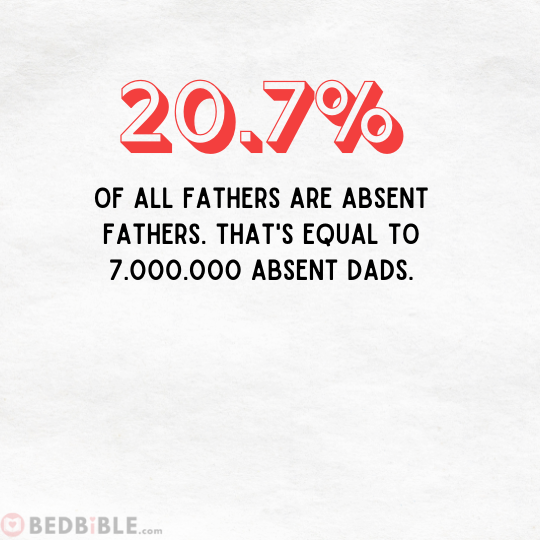
- in 2022, 49% of the absent fathers were in contact with their children 1-2 times per. month.
1.2) Children with no fathers
- 1 out of 4 children (23.6%) lives without a biological, step, or adoptive father. To be more precise it’s 15.782.000 children that live in fatherless homes in America.
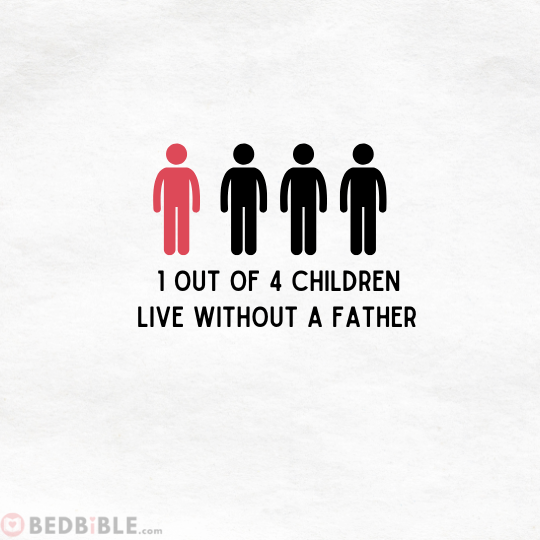
- The development of children living without their dad/father is increasing. It has doubled since the year 1968.
- Children living only with a single mother or a single father in the U.S. from 1940 to 2030.
| Year | Only Mother | Only Father |
|---|---|---|
| 1940 | 3,520,000 | 430,000 |
| 1945 | 4,959,000 | 515,000 |
| 1950 | 5,399,000 | 547,000 |
| 1955 | 6,012,000 | 608,000 |
| 1960 | 6,723,000 | 672,000 |
| 1965 | 7,210,000 | 725,000 |
| 1970 | 7,452,000 | 748,000 |
| 1975 | 10,231,000 | 1,014,000 |
| 1980 | 11,406,000 | 1,060,000 |
| 1985 | 13,081,000 | 1,554,000 |
| 1990 | 13,874,000 | 1,993,000 |
| 1995 | 16,477,000 | 2,461,000 |
| 2000 | 16,162,000 | 3,058,000 |
| 2005 | 17,225,000 | 3,497,000 |
| 2010 | 17,283,000 | 2,572,000 |
| 2015 | 17,006 | 2,751,000 |
| 2020 | 15,310,000 | 3,270,000 |
| 2022 | 15,782,000 | 3,442,000 |
| 2025E | 16,220,000E | 3,652,000E |
| 2030E | 19,761,000E | 4,821,000E |
1.3) Statistics of Fatherless Homes by Race
- A few studies have found it significant that there is a connection between the lower levels of education when being an Afro-American and the possibility of being an absent father. This is backed by the following stats; 57% of the fatherless homes in the US are owned by an African-American, 28%, and 15% [Wiley Online Library]
- Further, the race analysis shows, that if you are a young white adult. You have a better chance of finishing an education if you grow up with two parents, compared to living with only your mom as a single parent. The same goes for the probability of ending up in jail. This is valid for both men and women [FamilyStudies]
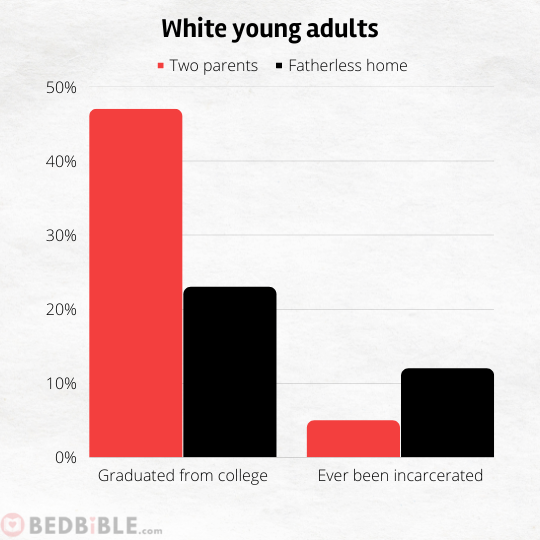
OBS: Due to ethical reasons, we didn’t do our research on this, so the findings here rely 100% on Wiley Online Library and family studies
2) Consequences and health risks of a fatherless home
This area is not well-researched. We are therefore one of the few media that has the newest information about the consequences for children. In general, it is connected with a lot of uncertainty to grow up in a fatherless home. Analysis shows that the children lack the competencies of a fatherly person. Which sooner or later can affect; personality, career, relationships, and much more. It is therefore super important that the parents take this seriously.
Our data have found that when a child is in a father-absent environment. They are influenced badly by:
2.1) 4x greater risk of poverty
It does something to the mind when you lack one of your parents. In fatherless homes, the economy is, obviously, not as good as it could be (compared to two incomes). This leads to a child who does not learn important stuff about how to handle money wisely. Which unfortunately for society and themselves will affect them later on. They do have a 4 times higher risk of poverty compared to if they had their dad home.
2.2) More likely to have behavioral problems
When you don’t have a father at hand, and your single-parent mom is super busy getting everything to work in the house. The child’s “minor” problems will not all the time be taken care of. This leads to the fact, that they more frequently compared to similar children with both parents, get into behavioral problems. This is measured by the time they are in contact with psychologists, therapists, public institutions, etc.
2.3) 2x greater risk of infant mortality
When you’re super busy at home and maybe not have the surplus to handle a kid with behavioral problems. The child gets into more problems and thereby exposes himself to more risk (bad environment). Could be seen by the location where the family lives, the friends the child is together with, etc. All in all, this leads to the fact that you’re 2x more likely to be “hit” by infant mortality as a single-parent child.
2.4) More likely to go to prison and commit a crime
When from an early age are “forced” to live in low-income areas, you’re more likely to be together with like-minded people. Low-income areas do have a higher criminality rate.
2.5) 7x more likely to become pregnant as a teen
You’re more likely to get a child early since you’re around people with whom this is more normal, and because you may not be that cautious when having sex. The single-parent child also has their sexual debut before anyone else (4 years before).
2.6) More likely to abuse drugs and alcohol
When you don’t have as many rules and regulations in your home as your like-minded friends. You’re more exploratory. This can be seen in the stats saying children of absent fathers are more likely to abuse drugs and alcohol.
2.7) 2x more likely to drop out of school
When you don’t have the necessary support from home to get help with your schoolwork. Then will the probability of dropping out increases.
2.8) More exposure to suicide in high school
All in all, this leads to a higher risk of committing suicide at a young age. More specifically they are 2 times more likely to commit suicide than children that has 2 parents.
3) Most common explanations for an absent father
We’re all unique, and that’s correct, but we do still see that certain segments do have similarities. This is also the case for absent fathers. The majority are pretty similar and do have stories, and personality traits that make it possible to group them or indicate a trend for which you as a relative should look out.
3.1) 1 out of 3 absent fathers (33%) never married
- 1 out of 3 absent fathers never married. That’s more than double compared to 15% of all fathers of minor children.
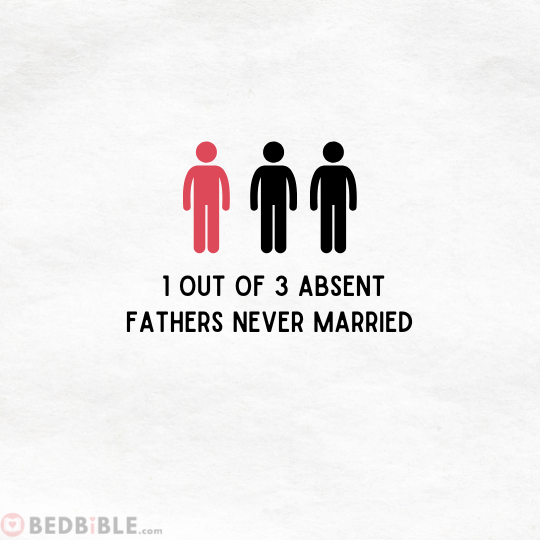
3.2) Almost 25% of all absent fathers do have a child with more than one woman
- Also, something that’s significantly above average when we compare it to the average dad.
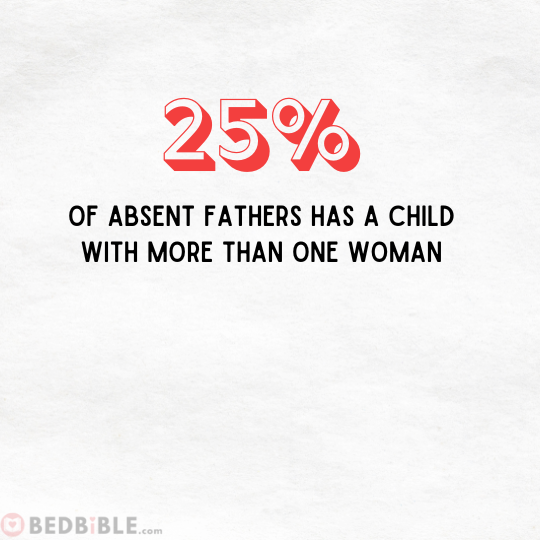
3.3) Absent dads do not have a college degree
- Compared to all other dads of minor children. More nuanced you are more likely to not have a college degree if you’re defined as an absent or solo dad.
4) General absentee father statistics
- 75% of people living in the US think that a child with only 1 parent (fatherless home). Is one of the biggest family problems the country is facing.
- 68% of all children in the world spend their time in a two-parent house.
- 3 out of 4 rapists commit the crime due to feelings that involve an absent father.
- 9 out of 10 that run away from home come from a fatherless home
- 6 out of 10 young people who commit suicide come from a fatherless home
- The median income from a fatherless home is 35.400 dollars pr. year. A household with two parents has a median income of 85.300 dollars pr. year. In other words, that’s more than double the two patterns a household earns compared to a single-parent one.
- Mississippi is the state with the highest amount of absent fathers. Almost 40% of households have a fatherless home.
- The average and modern father is 8 hours together with his child. This is 6 hours less than the mom.
How is an absentee father defined?
An absent father also called a fatherless home is in this statistical piece/report defined as a home where the father does not live (has an address). We are aware of the fact that it’s possible to be an absent dad and still have an address in the same place as the children. But to avoid any misinterpretation of data and thereby incorrect conclusions we’ve solely defined an absent dad as one that does not live at the same address as the child.
Conclusion
The above stats on fatherless homes or statistics on absent fathers are a bit shocking to us. It’s a bigger problem than I first thought. There is no doubt that absentee fathers are affected directly and indirectly. Directly the families and friends. Indirectly society has to pay for all the damages the fatherless child is generating.
It’s such a big problem that’s something almost all countries are trying to handle. But as you can probably imagine it’s difficult to interfere in people’s private life. And as you already know it’s super difficult to get to adopt a child, to get one if you’ve not had a stable private life before, for which there are a lot of reasons.
The morale is 100% that of course, something can happen that you can’t plan for, but in general, you should be aware of the response you’re given when becoming a parent. It has a huge effect on everything around you.
Being a new daddy means being the child’s protector while unleashing the little kid trapped inside you. Have fun with your kid and don’t forget how fast time flies by. Spending time with your kid now will help strengthen your relationship with them as they grow older.
– Happy Father
